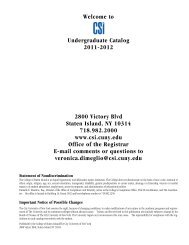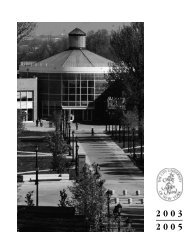Csi undergraduate conference on research, scholarship...
Csi undergraduate conference on research, scholarship...
Csi undergraduate conference on research, scholarship...
You also want an ePaper? Increase the reach of your titles
YUMPU automatically turns print PDFs into web optimized ePapers that Google loves.
Research Poster Presentati<strong>on</strong>s<br />
P O S T E R 3 7<br />
Unraveling the Structural Basis<br />
of a Snake Toxin/Potassium<br />
Channel Interacti<strong>on</strong><br />
T<strong>on</strong>y Jin<br />
Faculty Mentor: Dr. Sebastien Poget<br />
Department of Chemistry<br />
Presentati<strong>on</strong> Abstract: Potassium (K+) channels are<br />
integral membrane proteins that, when activated,<br />
allow highly specific K+ i<strong>on</strong> flux through the<br />
plasma membrane of cells at near-diffusi<strong>on</strong> rates.<br />
They play central roles in such physiological<br />
processes as neurotransmissi<strong>on</strong>, secreti<strong>on</strong> of<br />
insulin, and regulati<strong>on</strong> of the heartbeat. KcsA is a<br />
bacterial potassium channel known to share<br />
homology with K+ channels of most other species,<br />
including humans.<br />
Certain varieties of toxins, pois<strong>on</strong>ous biological<br />
peptides, have l<strong>on</strong>g been known to target potassium<br />
channels, collectively causing cardiac arrest and<br />
respiratory failure. These toxins typically work by<br />
binding to potassium channels to restrict K+ i<strong>on</strong> flow.<br />
However, we isolated a toxin—coined Tx7335—from<br />
the venom of the Eastern Green Mamba (Dendroapsis<br />
angusticeps) and discovered via electrophysiological<br />
assay that it increases the frequency of activati<strong>on</strong> of as<br />
well as the durati<strong>on</strong> of openings, leading to an<br />
increase of K+ i<strong>on</strong> flow through KcsA—a rare effect<br />
am<strong>on</strong>g toxin-channel interacti<strong>on</strong>s.<br />
This project aims at unraveling the structural basis<br />
underlying KcsA’s increased frequency of activati<strong>on</strong><br />
up<strong>on</strong> binding of Tx7335, via methods of 2D<br />
soluti<strong>on</strong>-state protein NMR spectroscopy. Our<br />
current approach involves 1) creating a soluti<strong>on</strong> of<br />
KcsA that gives optimal spectral quality, 2)<br />
assigning each peak in the spectrum to its<br />
corresp<strong>on</strong>ding amino acid residue, and 3)<br />
examining changes in peak positi<strong>on</strong> up<strong>on</strong> additi<strong>on</strong><br />
of the toxin, which will reveal the locati<strong>on</strong> of the<br />
Tx7335 binding site <strong>on</strong> KcsA. So far, we have found<br />
a detergent species that allows us to rec<strong>on</strong>stitute<br />
KcsA and m<strong>on</strong>itor toxin binding. We are currently<br />
further optimizing NMR sample c<strong>on</strong>diti<strong>on</strong>s.<br />
C<strong>on</strong>clusive findings from this project will further<br />
our understanding of the biophysical driving forces<br />
in K+ channel activati<strong>on</strong> and may aid the design of<br />
novel and more effective K+ channel openers—<br />
presently used to treat hypertensi<strong>on</strong> and hair loss—<br />
as well as other drugs that act by modulating K+<br />
channel activity.<br />
44<br />
P O S T E R 3 8<br />
Substrate-Dependent Regulati<strong>on</strong><br />
of Cytochrome-2E1 (Cyp2E1)<br />
Activity in Mouse Primary<br />
Hepatocyte Culture<br />
Kaitlin Kelly, Diana I. Aparicio-Bautista<br />
Faculty Mentor: Dr. Jimmie E. Fata<br />
Department of Biology<br />
Primary hepatocyte cultures are widely used for in<br />
vitro investigati<strong>on</strong> and as a screening tool to<br />
evaluate hepatic metabolism, cytochrome P450<br />
(CYP) inducti<strong>on</strong> or inhibiti<strong>on</strong>, and hepatotoxic<br />
potential of xenobiotics. However, the use of<br />
cultured hepatocytes in these applicati<strong>on</strong>s is<br />
dependent <strong>on</strong> adequate and relative stable<br />
expressi<strong>on</strong> of CYP enzymes over the culturing<br />
period. The culture c<strong>on</strong>diti<strong>on</strong>s, in particular the<br />
c<strong>on</strong>figurati<strong>on</strong> of cell-substrate interacti<strong>on</strong>s and the<br />
formulati<strong>on</strong> of culture medium are crucial for<br />
maintaining the activity of CYP enzymes.<br />
Cytochrome 2E1 (Cyp2E1), a member of the<br />
cytochrome P450 family is involved in the<br />
oxidative metabolism of different substrates such as<br />
tobacco derived N-nitrosamines and benzene,<br />
which are potential carcinogens in breast tissues of<br />
human and rat respectively. In this study, we<br />
evaluated the Cyp2E1 enzyme activity of mouse<br />
primary hepatocyte, which were cultured 48 hrs <strong>on</strong><br />
three different substrates; plastic, collagen type I<br />
and Matrigel (basement membrane). Our results<br />
showed that the level of enzyme activity of Cyp2E1<br />
increased significantly using Matrigel as substrate<br />
when compared to collagen type I or plastic. These<br />
results suggest that Matrigel is an effective way to<br />
maintain the optimal cytochrome activity in mouse<br />
primary hepatocyte cultures.





